All new Finnish made outdoor products are rare. Especially interesting and well working ones. This post is about one of the gems: OAC Kar 147 backcountry skis, or fastshoes, i.e. something between a snowshoe and a ski. In the post there is some background information, some numbers, my initial impressions and comparison to the Altai Skis Hok 145 the “original gliding snowshoes”.
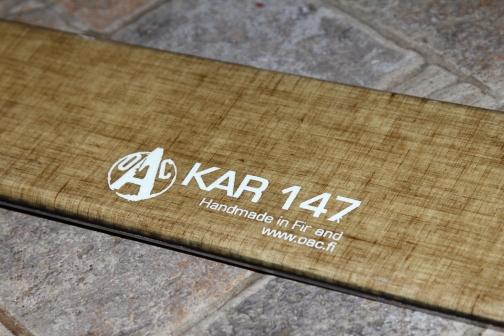
OAC Kar 147 – the gliding snowshoe goes backcountry ski?
Not a ski, not a snowshoe but something in between. Natives of the Northern areas have always used also shorter skis with climbing skins for certain needs and inspired by the short skis of the natives of the Altai mountain the US-based company (with production somewhere overseas) introduced the Altai Skis Hoks: 125cm and 145cm long short and wide skis with permanent skin inserts. I had a pair of the 125cm model for test and published my initial impression on the blog about a year ago. In short: I liked them a lot. Loads of fun and good tools for forested areas in winter.
The Finnish importer of the Altai Skis is OAC and they wanted to change some aspects of the skis which soon lead to the birth of two updated skis based on the idea of the Hoks. The OAC still imports and sells Altai Skis Hoks but now they also produce and sell their own skis: Hok 145 like OAC Kar 147 and more XCD-ski styled OAC TAO XCD 160 – both designed and made in Finland! The TAO XCDs I wish to test later this winter when OAC gets the production running but this post is about the Kar 147.
The OAC skis are marketed as “backcountry skis” and the Altai Hoks as “original gliding snowshoes” and this seems to be somewhat true when comparing the Kar 147s to Hok 145s: the latter are a bit closer to snowshoes while the first are a bit more ski-like. Both are still in a category of their own being very short (for a XC-ski), quite wide and having permanent skin inserts.
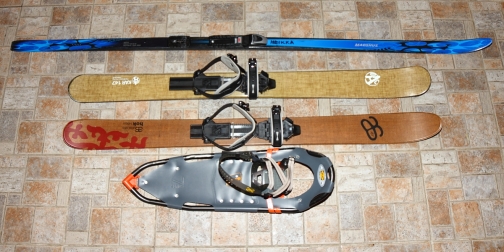
Tools for travel: Madshus VOSS 205cm, OAC Kar 147, Altai Hok 145 and Atlas 730.
OAC Kar 147 vs. Altai Skis Hok 145 – side by side
Dimension-wise the OAC Kar 147s are quite close to the Hok 145s. The Kars are nominally the 147cm long and the Hoks 145cm long. The width is about the same (measured without any precision instruments): 128mm – 110mm – 122mm for the Kar and 124mm – 110mm – 122mm for the Hok. Both have also permanent skin inserts, full steel edges, a bit of camber, nicely raised tip and also some raise in the tail.
There are also differences: The most notable difference is different placement of the binding. On the Kar 147s the binding is placed so that the pivot of the X-Trace binding (or the pinline in 75mm NN binding) is on the balance point. On the Hok 145s the binding is considerable more forward, approximately about 10cm in front of the balance point. (In the Hok 125s bindings are placed on the balance point.)
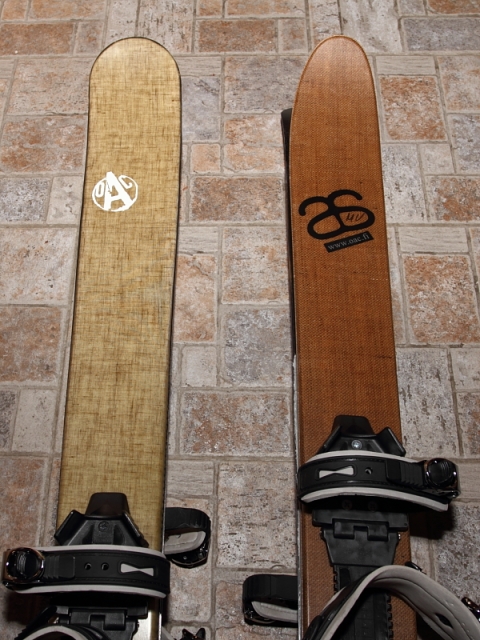
Other differences include:
– Different tip and tail design: The tip of the Kar 147 is wider and doesn’t raise as much as the tip of the Hoks.
– The Kar 147s are also little bit wider on the tip, only about 4mm but wider anyway.
– And (something I consider important) the Kar 147s have about double the camber the Hok 145s have, when you strap the Kars together they fit a standard match box between them easily, the camber of the Hoks is about half of that.
Both feel about equally stiff though the Kars have more initial flex before stiffening towards the end when being pressed flat against hard surface. I assume this is because of more camber providing a longer flex range.
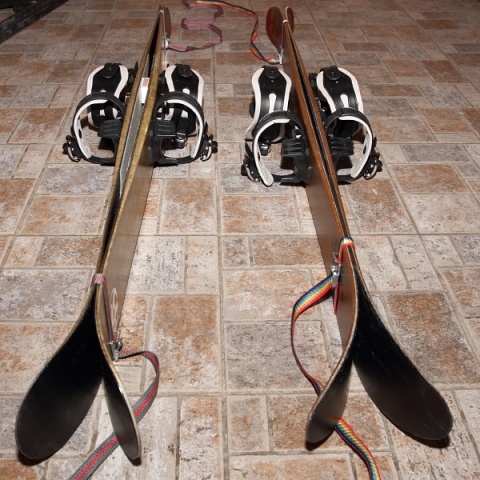
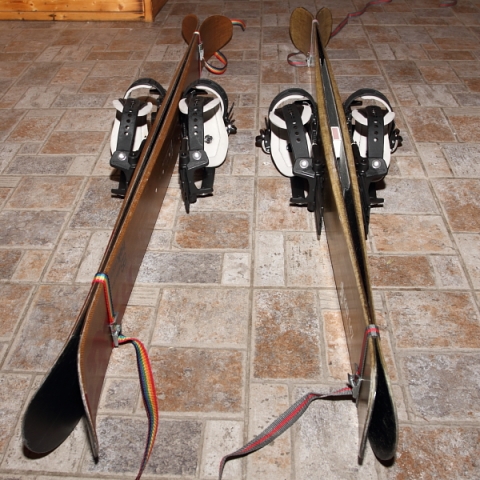

The Hok 145s weight 1892g per ski with the X-Trace Pivot bindings . The Kar 147s weight 1790g each with the same binding meaning the Kars are 100g lighter per ski. They are listed to weight 1150g without any bindings but as mine are clued on so can’t check.
OAC Kar 147 vs. Altai Skis Hok 145 – in real life
I haven’t had time to do very thorough testing (in my opinion that would take at least one whole winter season with varying use and conditions) with the Kar 147s and Hok 145s but I’ve used them enough to get on idea how they perform in deep soft snow and on packed trail in rolling, forested terrain. Both of the skis are equipped with X-Trace Pivot universal bindings and I’ve used them with Meindl hiking boots and Sorel winter boots. More on the binding to be written later…
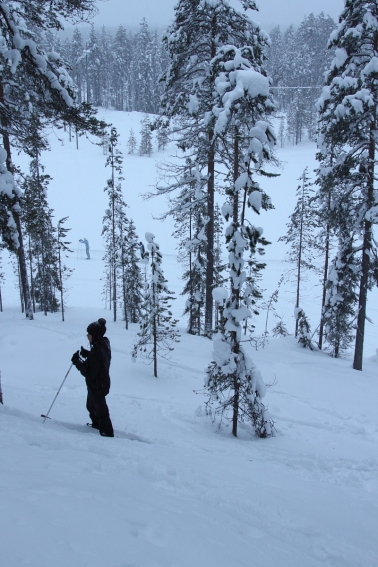
N zig-zagging up about 25-30 degree slope. She hates steep stuff on normal skis but is quite comfortable with the Hoks and Kars.
I’ve skied around in gently rolling forests and flat swamps with deep soft snow, pulled sled on the track and off the track, climbed 25-30 degree slopes with soft snow and skied them down doing turns with my bad technique – and had fun all the time! And that is what the Hoks and Kars are about in my opinion: fun tools for winter travel.
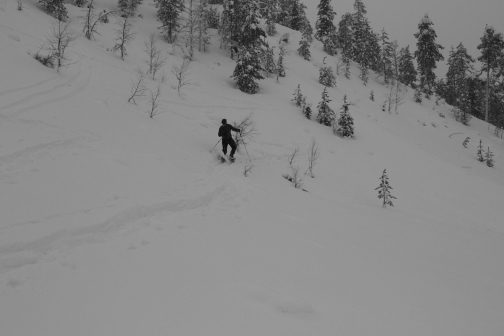
Me going up…
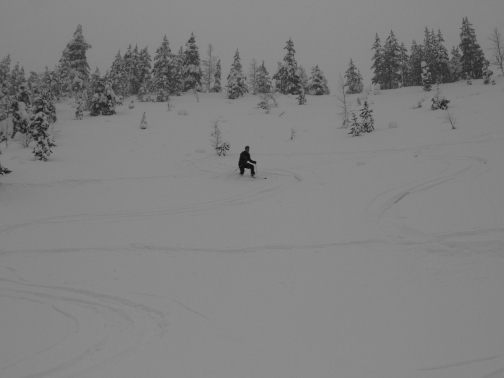
… and trying some telemark on the way down.
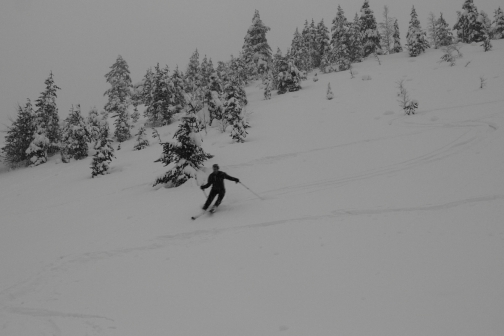
And coming down again. Damn it’s fun!
The Hok 145s feel and act like the Hok 125s but being longer there is more surface area and thus they provide better floatation, a nice feature for someone in my weight class or if using them with a heavier backpack. Being only 145cm long they are still very agile in my opinion, basically just as agile as the 125cm version. (Take into account that I’m 186cm, for considerably shorter people the shorter version might feel more agile.) And as the binding is moved in front of the balance point the Hok 145s distribute the weight quite equally and thus sink in the snow in horizontal position instead of going “tail first”. The binding placement also gives them a bit more snowshoe-like feeling when compared to normal skis, or the Kar 147s.
The Kar 147s feel a bit more ski-like than the Hok 125 and even more than the Hok 145s. They track better on hard surface and are easier to control when going downhill but as a downside the tail of the ski sinks deeper than the tip in certain conditions (especially on soft snow on top of almost supporting layer of crust). I think this is because they have more camber and mostly because the binding is placed into the balance point as on normal skis. The advantages are clear and the downside is familiar for most people who use skis in similar conditions meaning that most can live with that but for some it might be an inconvenience.
The wider and flatter tip and tail work just as well as the more tapered and higher raised ones of the Hoks: the tip jumps on top the soft snow when gliding the ski forward and you can do 180 degree turn on hard surface just as easily as with the Hoks (but in both cases the skins stop you instantly and damn near knock you over). The Kar 147s also have slightly smaller skin insert which (according to the people of OAC) is made of higher quality material and thus it should give the same grip with less friction but as the test pairs I had were of different age, I can’t verify this. Both provide easily enough friction to haul a 60kg sled on hard surface, easily enough grip to navigate in soft snow on gently rolling terrain but not enough grip to push directly up 25 degree slopes with soft snow, those have to be zig-zagged up. The grip is naturally better on hard surface.
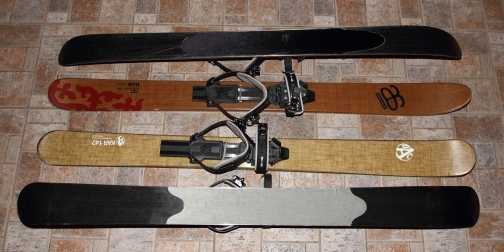
Initial verdict
As a simplified and very much precursive verdict I’d say that the Kar 147s are still mostly like the Hok 125s I tested a year ago but with some differences:
“They work and they are fun.
They are very maneuverable and provide decent good floatation.
The Kars Hoks seem to be sort of go-anywhere-do-anything tool but such things come with compromises.”
This time the compromise is taken closer to a ski and a step away from the snowshoe. This gives better tracking, better control for downhill and more ski-like feeling but at the same time looses some of the snowshoe-like feeling in deep soft snow. And of course the bigger surface area gives better floatation. In my opinion the Kar 147s are more ski-like and thus well suited for people looking for agile backcountry skis or something to have fun on local hills. On the other hand the Hok 145s are probably better tools for traveling on soft snow with gentle terrain and also maybe better suited for people who plan to use them a lot without poles (photography, hunting, etc.)
Which ones you prefer, is up to you.
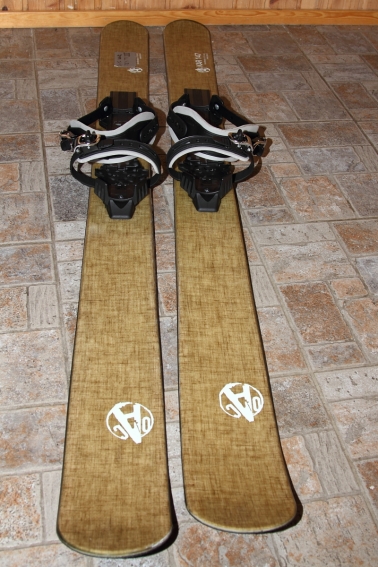
Availability & price
In Finland the OAC Kar 147 are available from the usual suspects like Partiokauppa (399eur with bindings, not in stock) and SOS (419eur with bindings, in stock. The best price I’ve seen this far, and the only retailer listing the Kar 147s also without bindings, is from Hiking Travel HIT at Ylöjärvi (near Tampere) who has them for 285eur without bindings and 390eur with the X-Traces.
– – –
Disclaimer: The nice people at OAC Finland lended the skis for me for test on request but with no obligation of reviewing them. And unfortunately I have to return them.
Jaakko Heikka - Professional wilderness guide and diehard outdoor enthusiast with a special interest for lightweight backpacking, arctic expeditions and outdoor photography.














Thanks for the initial impressions of these skis.
Now I have to make the decision which is the best for me.
I will tell you which I bought
Very interesting. Thanks, Jaakko.
It’s hard to decide between the two, but for some reason, I’m veering towards the Hoks, mainly for the kind of terrain I feel I’m likely to use them on. The comment about not necessarily needing poles was interesting – why is that? Because of the binding position?
Looking at the bindings of each in comparison, I almost want to say that I’d like the Hoks to be back a few centimeters, and the Kars to be forward a few. Hard to say for sure without trying though.
Both work without bindings because of the great grip of the skin insert (just like my VOSS do with full lenght skins) but I feel that the Hoks are easier to “walk with” as the binding is more forward and thus the tails don’t sink deeper than the tips. If the tail goes deeper than the tip you’d want to have poles to making going forward easier.
I was thinking the smae with the binding but I think that would be a bad compromise and you’d probably loose both of the good charasteristics but still have some of the bad…
It’s hard decision between the two (or three if you also concider the Hok 125s).
Thanks for sharing your first impressions! I wonder how long the skin inserts will last.
thanks Jaakko. nearly bought the 125’s 2 months ago but glad I waited on your review. Some more thinking to do and I’ll probably wait till next season now. Very tempting for a newbie/non skier tho’
Yes, they are great tools for newbies. Noted that with several guide friends when testimg them. I’ll probably get some for customers to use.
Hi mate,
thanks for the quality review! It would be so cool if one could change the placement of the binding according to own preferences/ terrain. Does that seem possible?
Best regards,
Huck
The bindings should have a rail and be movable back and forth.
Thanks for all the comments folks!
Mikkel: I reckon they will last quite long in normal recreational use. In addition they can be also changed. I don’t know if OAC will start to offer a service for it or extra skin inserts but wide skin is available by meter and glue can be heated off. 😉
Huck & Muotka: I was thinking the same also. Simple DIY solution would be… The Hoks have metal inserts for screws: three in the front and three in a row in the back (to fit 75mm NN binding and heel piece). One could easily attach a home-made raiser piece (piece of plywood) to these inserts and mount the binding on it to the desired place. The Kar 147s I have lack the inserts in the heel but of course similar piece could be attached directly to the ski.
Cool, I didn´t know the skin could be easily replaced 🙂
I don’t know if it’s supposed to be but it should be… I’ll try to check this from the OAC but it might be that they don’t want to give official instructions for it. 😀
Nice review and good to hear your impressions about the skis. I bought the Kar 147 skis in the beginning of January mainly based on your preview from last year and your review of the Hoks. My impressions are quite similar to yours so far. They work well in rocky terrain or forested hills and are excellent on the sea ice. They are great for photography as it’s easy to ski with them even without poles. I’ve been extremely happy with them so far. Going downhill is great fun but for me it will require some more practice on the steeper slopes. 🙂 I snowboard so skiers might find it a bit easier and those who have mastered the art of telemark will feel right at home I suppose. The one long pole approach might be worth trying for steeper slopes.
Thanks for the comment, qwRad! I agree. Using a lurk (one big pole) for down hill was mighty fun with the Ho k125s but also requires some practise. Speaking of which, I should go and try it also with the Kar 147s.
What did you think about the bindings, Jaakko – when I saw the Hoks with x-trace bindings today they seemed to be very flimsy (very loose lateral movement, for example)
I don’t have enough experience about the X-Trace to really give a thorough answer, though I’m working on getting more experience and plannign to write a separate piece abotu them later.
But I feel that they are good bindings for XCD skiing. They feel little flimsy and seem little over-complicated (compare e.g. Icetrek Flexis) in my opinion. They are quite easy and “light” to ski on easy terrain but still provide quite good control for more difficult parts but of course not the same level as proper BC downhill bindings. This means skills are needed but it’s clearly possible to ski telemark with them or kite-ski with them with a heavyish pulka in tow.
And of course the characteristics of the system depend also on your skis and boots. It’s quite different ball game to ski with Inov8s or stiff mountaineering boots.
The only thing I’m uncertain about is the structure. They seem too complicated for me (even though they are quite simple) and I need to get reasonable amount of kilometers out of them before I’d trust them for a logn demandign expedition.
Yeah, I’d agree from what I’ve seen so far. They look good for general use, but I suspect I’ll end up putting some 3-pins on, as I doubt I’ll be skiing in inov8-s much. Although, slapping any old boot in them is definitely an advantage.
I’m quite interested in the idea of doing late spring trips with Hoks/Kars/Taos to Käsivarsi area: maybe combine hiking, skiing and packrafting. There the universal binding is an advantage. Same goes for very cold mid-winter trips and using them as a spare skis on group trips (also makes spare boots unnecessary). Lots of use comes in mind.
I bought mine OAC Kar 147 with the X-Traces from Häijää haijaa.fi and the price was 379 euros. I have been testing KARs here in Kuusamos forests and Ruka and enjoy a lot!
Do you think Hoks could be used for backcountry touring with a Pulk or would a combination of skinny skis and snowshoes be better? I’m concerned that the Hoks would not have enough traction to pull a Pulk uphill. are there any ski crampons that will fit the Hoks?
Hi Bob!
In my opinion Hoks (or Kars) would be the perfect tool for ski touring in forested areas with soft snow, with pulka or without. I did a four-day tour with big pulka (Fjellpulken Xpedition 168) in Eastern Finlan with the Hok 125s and would’ve been in trouble with the traditional long (250cm) forest skis in the dense woods. And Hoks also doubled as snowshoes for camp chores.
But the traction on steep uphills is limited compared to long skis with, say, full-length 50mm wide skins. I guess you could attach extra skins to Hoks for the steep stuff and go with the fiexed inserts on easier terrain.
I’m not aware of any fitting ski crampons but if you’d choose 75mm tele bindings there should be some for tele bindings for wide off-piste powder skis and those might work…
Well I’ve purchased 145cm Hoks for my trip in February to Inari and Karasjok. I’m making some crampons for them out of 3mm thick titanium sheet. Let’s hope we get some cold weather soon! Do you know of anywhere in Ivalo where we can buy fuel for our MSR XGK stoves?
Hi, Bob! Nice to hear your going to use Hoks on a proper winter tour. Please, share your experiences after the tour! Don’t know if you really need crampons there, maybe just strip of extra skin for the tip. Neste gas stations sell “Neste Green 4T” fuel (for chainsaws and similar small engines) in green 5L plastic canisters. Works well in MSR stoves. But: nearest Neste station is 30km further South at Saariselkä. Other gas stations at Ivalo might sell similar fuel.
Thanks for the reply, I’ll try and get some 4T from the shops in Ivalo, I guess it’s similar to Aspen 4T that we buy in Norway. I remember seeing a few hardware stores which may sell such products. If not I’ll use my spirit stove. I’ve noticed a few reports on Hok type skis where people have used grip wax on the skin, do you think this is worthwhile?
I will be posting my trip report on bushcraftuk and on wintertrekking.com again. There are a few trip reports posted last year about trips to Finland and Norway.
Hi again Bob! I don’t see any point in using grip wax ON the skins. It actually sounds plain stupid to me. But soft parafin glide was prevents skisn from freezing (sports shops sell was meant for skins) and ading grip wax OUTSIDE the skins naturally adds grip if you need some more.
Hi Jakko, have you posted anything further regarding the OAC and HOK comparison, specifically have there been any major modifications to either of these products since this original post? Have you had a chance to review the bindings?
Thanks for a great write up!
Len
Hi Len! Sorry, no posts on the OAC/Altai Skis topic but since writing the original piece I’ve skied with OAC XCD 160 and own two pairs of OAC Kar 147s. I haven’t followed the developments of the Altai Skis but OAC keeps improving their skis from season to season. In short:
– The XCD 160 is very much a short ski instead of a gliding snowshoe. Small amount of skin gives good glide but less grip (you could probably add a separate piece to the front if needed). Not so much floatation but very light. I’ve used them as spare skis on expedition with big groups.
– The Kar 147 is heavier and slower (more skin area = more grip & less glide) but gives decent floatation. My go-to choise for shoulder season skiing and thick bush (with need for hands free).
– The new X-Trace EA binding has slightly better feel into it than the old Pivot and is a lot easier to adjust. Both are good if you, for some reason, don’t want to use a real ski binding and boot (for example shoulder season trips with quite a bit of walkign included). You can also use hard mountaineering boots with them even though it is not recommended (might stress the binding?) to keep you feet cozy and warm.
Hi, Has anyone tried a 75mm telemark binding on these skis? like a G3 Targa Ascent or Black Diamond 01.
Gordo: The skis come pre-drilled with holes suitable for 75mm NN bindings so why not? Beefier binding and boot would offer more control if needed. Though for me they are shoulderseason and all-around tools and thus I like wearing “normal” footwear with them.
Dave of Bedrock and Paradox used to have 75mm bindings in his Altai Hoks: https://bedrockandparadox.com/2012/03/17/145-altai-hok-review/
Thanks for the link. I may try it with some spare Targa Ascents and an old pair of T3 boots I have lying around.
Now this is a difficult choice between Hok 145’s and Kar 147’s! I’ve tried Kar 147’s for few times, never seen Hok’s except on the screen. Kar’s tails really sink in soft snow, but are pretty skiiable generally. I’m just thinking how much different Hoks would be with more forward binding placement, how much more flotation they would give in soft snow. Well, I guess the only way would be to try both in same conditions. Kar 147’s are made in Finland, but wonder where the Hok 145’s are made in?
Hi Pasi! My memory and feeling is that both Hok 145s and Kar 147s float or sink about as much but in different manner: the Hoks stay more horizontal while the Kars sink tail first, which is annoying at times but also helps to push the tips back to the surface. Worth noticing than the Altai Skis now also have a longer model named Kōm. A different type of a short ski which might serve some better than the wide skinbased skis. According to the FAQ Altai Skis are made in China: http://altaiskis.com/faqs/
Hi Korpi-Jaakko. I think tail sinkin first is good exactly for the reason you wrote. But too much can be annoying. Well, this all depends on the snow conditions of course. I found their website after I wrote my comment. Kōm would be probably perfect choice in size for me, bit more flotation, probably more skiable, but still maneuverable. If they would only have a skin base, like Hok and Kar. Plus I think they seem to be hard to get in Finland. Have to say that made in China lessens my interest a bit, as too many products are made in so called cheap labour countries. Quality can of course be good still. Might be that I’ll get the Kar 147’s this time.
There is some great topics discussed here about “bush skiing”.I ski in Ontario, Canada just north of the Great Lakes.
Great to see more options entering the market.I had worked my way up to Rossignol BC 125
skis in the 185cm length after testing ski widths by glueing two sets of old wooden skis together.
I also saw skis being hand made by splitting spruce in Werner Herzogs documentary “Happy People”.The 125’s have poor grip in powder and are heavy but I’ve been making good use of them. We had several seasons with close to a meter of powder with no crust at all,
so maximum floatation was crucial. A little extra length helps that as well as spanning ditches and open creeks. I believe longer skis also support better on very thin ice, span loading vs area loading? Of course if there is a crust with 10-15 cm of powder then I use my Madshus Eon’s.
We often get slushy conditons on lakes and beaver ponds especially as the mass of snow on the ice surface increases. I often avoid icing up with the wide 125 skis, especially if I help support my weight with my ski poles. I wonder how the mohair would do if it had slush freeze to it?
In spring conditions I struggle to keep my bases from clumping with snow no matter what wax or treatment I try.
I wonder what the Unicoat base is like on the OAC’s? The OAC line-up is being carried by MEC here in Canada so I am anxious to visit one of their stores soon to check out a pair of Kar 147’s or the shorter units. I hate to have so many ski’s but with the EA
binding I could perhaps coax a friend or my girls to try bush skiing!
Thanks for you comment Janne! I’ve never had the skins in the OACs seriously frozen but I’ve alway found mechanical removing ice from skins (in the OACs or separate skins in long skis) quite easy. I also believe tyhat in certain conditions all bases ice up so no way around it. Carrying liquid glide wax and scraper helps.
For maximum floatation I’d go looking for traditional “forest skis” aka something around 3 meter long and 7-9cm wide. Not very maneuverable but they give a good floatation. In myu opinion the length is more important the width as it “opens track” for you and also helps to spread the weight on bigger area (it doesn’t seem to be only about the surface area of the ski itself but more complex…)
Happy skiing! Hope we’d get proper winter here this time…
I picked up some OAC 147 UC skis and mounted some telemark bindings on them. I’ve had them out for a few days in the fresh November snow we got near Ottawa, Canada. Really enjoying the fun factor of romping through the woods, sking some hills etc.. the small skins works better then I thought for uphill travel. I’m using some old T3 plastic tele boots with the kit and it works well.
I realise this is an old post, but I was wondering if you had any thoughts/experiences between the KAR147 and XCD GT 160? I’m keen to get my first pair of snow-shoe-skis for this winter for simplified winter hiking and getting a bit of experience in cross country skiing. Complete beginner – last skied 20 years ago! Here in Tasmania (southern Australia) we don’t often get the lovely powdery snow the rest of the world enjoys, it’s usually soft and wet, sometimes icy. While neither is ideal of icy/hard snow skiing, apparently the XCD GT 160s are a little better at biting into harder snow than the 147s, which are known to struggle. Would be keen to know your thoughts – thanks!